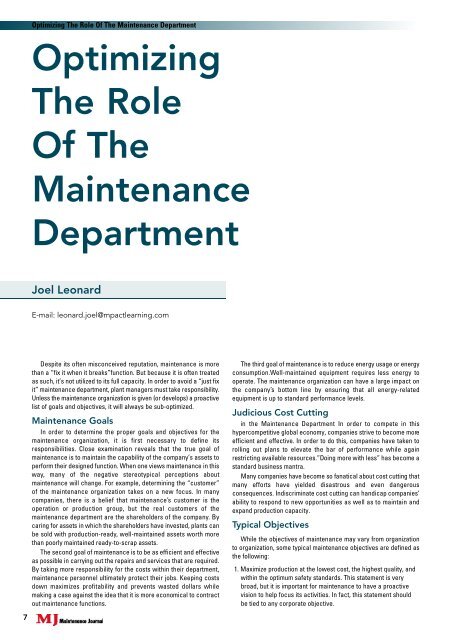October - Library
October - Library
October - Library
Create successful ePaper yourself
Turn your PDF publications into a flip-book with our unique Google optimized e-Paper software.
7<br />
Optimizing The Role Of The Maintenance Department<br />
Optimizing<br />
The Role<br />
Of The<br />
Maintenance<br />
Department<br />
Joel Leonard<br />
E-mail: leonard.joel@mpactlearning.com<br />
Despite its often misconceived reputation, maintenance is more<br />
than a “fix it when it breaks”function. But because it is often treated<br />
as such, it’s not utilized to its full capacity. In order to avoid a “just fix<br />
it” maintenance department, plant managers must take re s p o n s i b i l i t y.<br />
Unless the maintenance organization is given (or develops) a pro a c t i v e<br />
list of goals and objectives, it will always be sub-optimized.<br />
Maintenance Goals<br />
In order to determine the proper goals and objectives for the<br />
maintenance organization, it is first necessary to define its<br />
responsibilities. Close examination reveals that the true goal of<br />
maintenance is to maintain the capability of the company’s assets to<br />
p e rf o rm their designed function. When one views maintenance in this<br />
w a y, many of the negative stereotypical perceptions about<br />
maintenance will change. For example, determining the “customer”<br />
of the maintenance organization takes on a new focus. In many<br />
companies, there is a belief that maintenance’s customer is the<br />
operation or production group, but the real customers of the<br />
maintenance department are the shareholders of the company. By<br />
caring for assets in which the shareholders have invested, plants can<br />
be sold with pro d u c t i o n - re a d y, well-maintained assets worth more<br />
than poorly maintained ready-to-scrap assets.<br />
The second goal of maintenance is to be as efficient and eff e c t i v e<br />
as possible in carrying out the repairs and services that are re q u i re d .<br />
By taking more responsibility for the costs within their depart m e n t ,<br />
maintenance personnel ultimately protect their jobs. Keeping costs<br />
down maximizes profitability and prevents wasted dollars while<br />
making a case against the idea that it is more economical to contract<br />
out maintenance functions.<br />
The third goal of maintenance is to reduce energy usage or energ y<br />
c o n s u m p t i o n . Well-maintained equipment re q u i res less energy to<br />
operate. The maintenance organization can have a large impact on<br />
the company’s bottom line by ensuring that all energ y - re l a t e d<br />
equipment is up to standard performance levels.<br />
Judicious Cost Cutting<br />
in the Maintenance Department In order to compete in this<br />
hypercompetitive global economy, companies strive to become more<br />
e fficient and effective. In order to do this, companies have taken to<br />
rolling out plans to elevate the bar of perf o rmance while again<br />
restricting available re s o u rces.”Doing more with less” has become a<br />
standard business mantra.<br />
Many companies have become so fanatical about cost cutting that<br />
many eff o rts have yielded disastrous and even dangero u s<br />
consequences. Indiscriminate cost cutting can handicap companies’<br />
ability to respond to new opportunities as well as to maintain and<br />
expand production capacity.<br />
Typical Objectives<br />
While the objectives of maintenance may vary from org a n i z a t i o n<br />
to organization, some typical maintenance objectives are defined as<br />
the following:<br />
1. Maximize production at the lowest cost, the highest quality, and<br />
within the optimum safety standards. This statement is very<br />
broad, but it is important for maintenance to have a proactive<br />
vision to help focus its activities. In fact, this statement should<br />
be tied to any corporate objective.
















